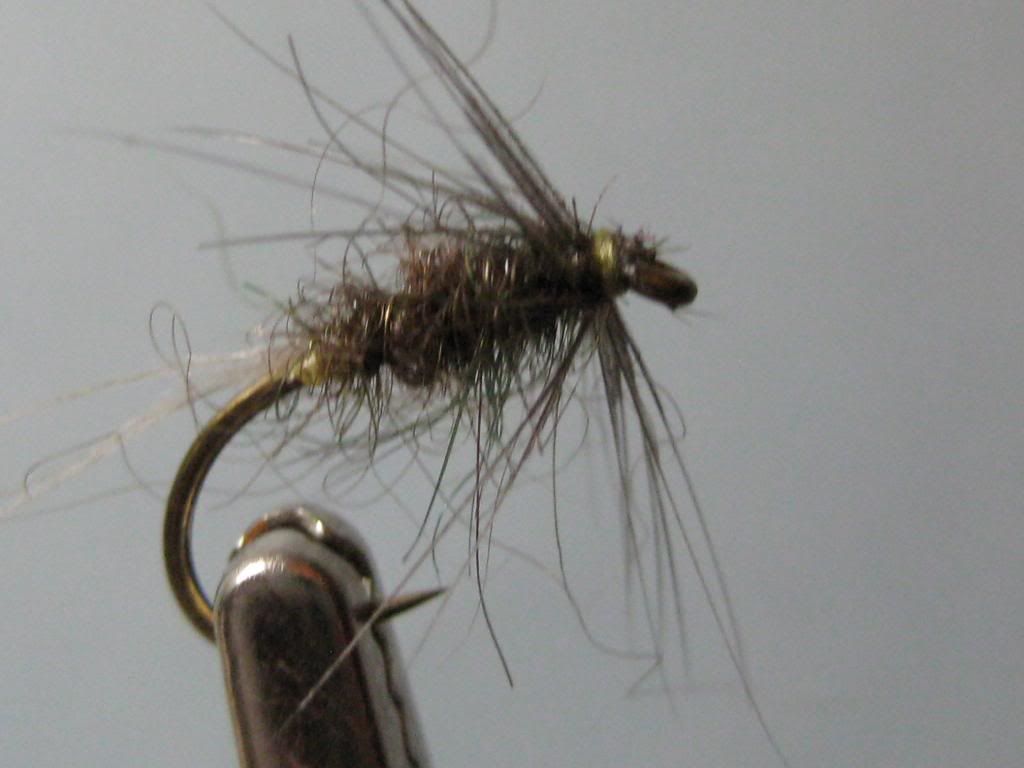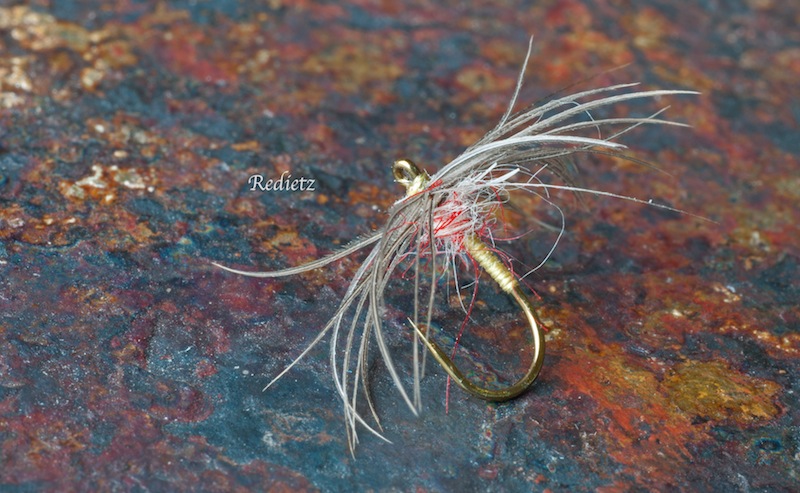Page 1 of 3
Dark Olive Nymph
Posted: Mon Sep 09, 2013 9:26 pm
by redietz
Here's a prototype that I've tied for the "orphan" swap:

I'm not entirely satisfied with it, beyond the poor execution. The bear is not soft enough to make the seal manageable, and I think the hackle is too long. Even from the same feather, I'm having a hard time getting the color in the tail to match the hackle.
The tying thread is unwaxed, I'm not sure that's correct either. I used bee's wax on the thread in the dubbing block, but it doesn't show very well.
I guess I'll persist.
Re: Dark Olive Nymph
Posted: Mon Sep 09, 2013 9:44 pm
by letumgo
Bob - Are you pulling the tail fibers from the same feather? They look like they are a much lighter fiber than the hackle. Seal is a tough dubbing to work with. I tend to use a very firm pressure when dubbing seal fur onto the thread. I've tried dubbing with and without wax, with varying results. I think in the PMD swap, I ended up getting the best results, when I waxed the thread.
More please!

Re: Dark Olive Nymph
Posted: Mon Sep 09, 2013 9:57 pm
by hankaye
redietz, Howdy;
I am doing the same fly for the Orphan swap, nice to see
what the color of the dubbing blend looks like. My proportions
may not be the same as yours, but .... that's the way of things.
If you don't mind me asking ... how are you applying the dubbing?
I've never worked with either Bear or Seal and from what Ray
mentioned, it might take some getting used to.
hank
Re: Dark Olive Nymph
Posted: Mon Sep 09, 2013 10:16 pm
by redietz
letumgo wrote:Bob - Are you pulling the tail fibers from the same feather? They look like they are a much lighter fiber than the hackle.
Yeah, that's one of the things that's bothering me. I may have to go with a darker neck to get the tail fibers I want.
Re: Dark Olive Nymph
Posted: Mon Sep 09, 2013 10:19 pm
by redietz
hankaye wrote:
If you don't mind me asking ... how are you applying the dubbing?
I've never worked with either Bear or Seal and from what Ray
mentioned, it might take some getting used to.
I'm using a dubbing block, and waxing the silk with beeswax before laying the dubbing on it.
Seal can reasonably easy to use if you mix it with something soft, like rabbit underfur, or muskrat, but the bear isn't a whole lot softer than the seal. I may try finding a third material to mix in just to make it easier to use.
Re: Dark Olive Nymph
Posted: Mon Sep 09, 2013 10:46 pm
by hankaye
redietz, Howdy;
Have you tried a shorter staple length?
I haven't started mixing mine yet but I'm
surmising that the lengths may be shorter
for the shorter hook lengths. I was thinking
of maybe 3/8ths inch. Or ..... just do something
like a twisted dubbing noodle as shown on pg.
139 of The Fly Tier's Benchside Reference to
Techniques and Dressing styles by T Leeson
& J. Schollmeyer.
Sure would appreciate any thoughts on the matter.
hank
Re: Dark Olive Nymph
Posted: Tue Sep 10, 2013 6:29 am
by redietz
hankaye wrote:redietz, Howdy;
Have you tried a shorter staple length?
I haven't started mixing mine yet but I'm
surmising that the lengths may be shorter
for the shorter hook lengths. I was thinking
of maybe 3/8ths inch. Or ..... just do something
like a twisted dubbing noodle as shown on pg.
139 of The Fly Tier's Benchside Reference to
Techniques and Dressing styles by T Leeson
& J. Schollmeyer.
Sure would appreciate any thoughts on the matter.
hank
Chopping the seal would be my absolute last resort. I've tied smaller with seal without chopping it, for example (borrowing Carl's photo) the red in my Tups swap fly was seal, it's a smaller hook, and just the thorax:

The seal is full length, and from the same source as the seal in the olive.
I like the effect of the seal on my current prototype, but it's not tapering very well.
Re: Dark Olive Nymph
Posted: Tue Sep 10, 2013 8:26 am
by William Anderson
Bob, I love to see your flies, and to know we're all actually trying to tackle something that isn't solved simply. Not to suggest I am enjoying that you're finding it difficult, but it does offer some relief that a tier like yourself finds it a challenge. I'm learning more from these recent swaps than in the all the past few years. Seal is a struggle for me. And adding bear didn't make it any easier. (your fly looks great, btw, not to suggest otherwise)
Maybe someone with more years working with seal can elaborate. It's something I haven't fooled around with much until just the past couple years. I have found that in using the block, or prespun bodies, at times that extra length can help bring the other fibers into submission and create a more dense, but more tapered body. Obviously there is a range, and I'd be interested to hear others techniques. If it's too short, you get wonderful, spiky fibers and too long you get binding that is undesirable. I chopped the bear and the seal to about a 3/8" with some longer and some shorter and I didn't get the body I'm looking for either. Any comments or assistance would be great.
I've seen Hans noodle twist seal on a dry thread and get just the right shape. It looks like he's done it more than a few times to me.

I know a couple others are working out how to manage the unruly fibers. For me the block gives me the most control in creating the body, but not to the extent that I have the desired result.
Thanks. I love this stuff.
w
Re: Dark Olive Nymph
Posted: Tue Sep 10, 2013 8:27 am
by fflutterffly
I'm still waiting for my hooks to arrive and I haven't even started tying my flies.
Re: Dark Olive Nymph
Posted: Tue Sep 10, 2013 9:08 am
by tie2fish
As for dubbing with seal, it can be notoriously difficult to work with. My guess is that part of the problem we have today is that most of the legal seal fur we can find has come from an adult animal and that "back in the day" (before PETA), tyers probably had access to more supple baby seal fur.
I have found that seal can be adequately twist-dubbed by a practiced tyer with the help of either a medium tacky wax or a modicum of saliva (if you're not fussy about such things). However, it is much easier to work with if you cut it up and make dubbing brushes -- either on a block or in a dropped loop or split thread. The shorter lengths do detract some from the resulting texture, but cutting the fur does not seem to alter its desired translucency.

